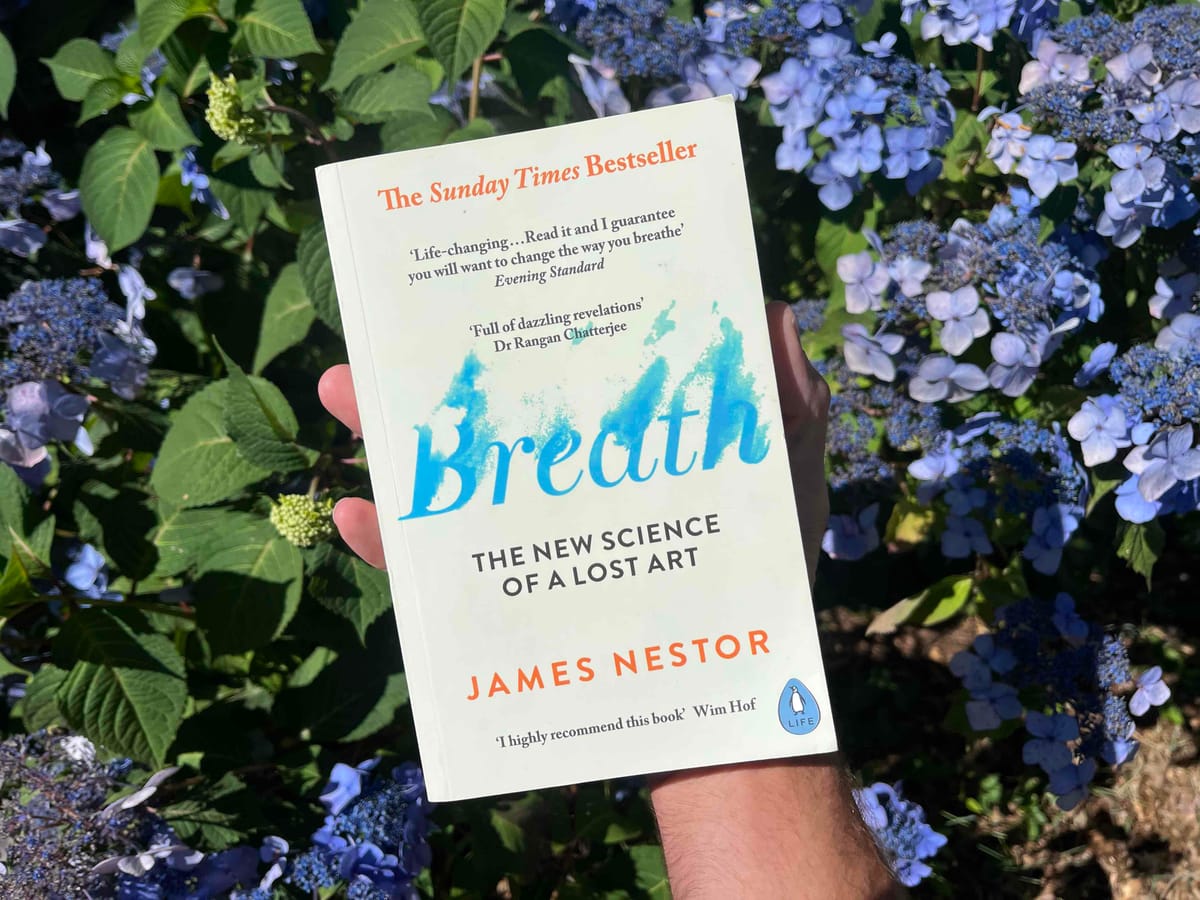Current Read - Breath, The New Science of A Lost Art

James Nestor's bestselling book is simply phenomenal. I may write a full review when finished, but I feel like I would be doing the people of Muskegon a disservice if I didn't share a few thoughts immediately. I began developing my nasal breathing habits 5 years ago. Jump to current day and I thought I was doing pretty well, but reading a few chapters of Breath reveals I have much to learn. Grab a copy and it may change your life...in the meantime, here are some elements of nasal breathing you may find useful:
Nasal breathing is more than just a way to take in air—it’s a cornerstone of physical and mental wellness that can reshape your health. Proper nasal breathing requires optimal facial posture, a focus on mewing, stellar tongue posture, upright neck alignment, and deep diaphragmatic breathing. When employed properly, nasal breathing calms and energizes the mind, reduces the risk of asthma and autoimmune disorders, and helps you stay present as the most effective "pilot" of your body.
Why Nasal Breathing Matters
Breathing through your nose filters, warms, and humidifies air, preparing it for your lungs. Unlike mouth breathing, which can lead to dry mouth, poor oxygenation, and increased stress, nasal breathing optimizes oxygen delivery and activates the parasympathetic nervous system. This promotes calmness, focus, and energy, grounding you in the present moment.
Key Benefits of Nasal Breathing
- Reduces Asthma and Autoimmune Risks: Nasal breathing produces nitric oxide, a molecule that dilates airways and blood vessels, improving lung function and reducing inflammation linked to asthma and autoimmune conditions.
- Enhances Mental Clarity: By regulating oxygen and carbon dioxide levels, nasal breathing stabilizes the nervous system, reducing anxiety and sharpening focus.
- Improves Physical Performance: Proper oxygen delivery boosts endurance and supports efficient energy use during exercise.
Techniques for Optimal Nasal Breathing
Here are a few of the techniques I've employed over the last 5 years of my nasal breathing journey:
1. Proper Facial Posture (Mewing)
Mewing, a technique popularized by Dr. John Mew, involves maintaining correct tongue and jaw positioning to promote facial structure and airway health. Sadly, Dr. Mew passed away this year, but his legacy is carried onward through the work of his son, Dr. Mike Mew. The video below details how to get started with Mewing.
A beginner's guide to Mewing.
2. Tongue Posture
Correct tongue posture is the foundation of nasal breathing.
- How to Practice: Ensure your full tongue, not just the tip, rests pressed against the palate (roof of mouth). This strengthens the upper airway and prevents mouth breathing. Your tongue should form a tight seal against the palate, so incoming air is channeled efficiently down the back of your throat, rather than swirling around in your mouth.
- Tip: Practice saying “ng” (as in “sing”) to engage the back of the tongue, then hold that position.
3. Neck Posture
Forward head posture, common from prolonged screen time, restricts airways and promotes mouth breathing.
- How to Practice: Align your ears over your shoulders, keeping your chin slightly tucked. Imagine a string pulling you upward from the crown of your head.
- Benefits: Opens the airway, reduces neck tension, and supports diaphragmatic breathing.

4. Diaphragmatic Breathing
Breathing from the diaphragm, rather than shallow chest or head breathing, maximizes oxygen intake and promotes relaxation.
- How to Practice: Inhale deeply through your nose, letting your belly expand while keeping your chest still. Exhale slowly through your nose. If your shoulders rise, stop and try again. You should feel your belly expanding downward and outward.
- Benefits: Lowers heart rate, reduces stress hormones, and enhances mental presence.
How to breathe with your diaphragm.
5. Additional Habits
- Nasal Clearing: There's nothing like a good old fashioned snot-rocket to clear your nasal passages. Plug one nostril and blast away, forcefully expelling the air from your lungs several times to open your airway. You can also do this with both nostrils open...like a bull, snorting before he charges.
- Mindful Breathing Exercises: Practice alternate nostril breathing (Nadi Shodhana) to balance energy and calm the mind.
- Avoid Over-breathing: Slow, controlled nasal breaths prevent hyperventilation, which can trigger anxiety or asthma symptoms.
- Sleep Positioning: Sleep on your side or with a supportive pillow to maintain open airways and discourage mouth breathing.
Additional Considerations for Nasal Breathing
To deepen the impact of your nasal breathing practice, consider these points:
- Oral Health Connection: Mouth breathing can lead to dental issues like misaligned teeth or gum disease. Nasal breathing supports proper oral posture, reducing these risks by keeping your mouth moist and free of excess gasses like oxygen and carbon dioxide.
- Exercise Integration: Train yourself to breathe nasally during low- to moderate-intensity workouts to improve endurance and reduce fatigue. Go for a light jog while mouth breathing. Then go for a light jog while nasal breathing. Note the difference in the "burn" in your muscles.
- Environmental Factors: Dry or polluted air can irritate nasal passages. Use air purifiers or humidifiers to maintain optimal breathing conditions. Don't pluck or heavily trim your nasal hair!
- Stress Management: Nasal breathing activates the vagus nerve, helping regulate the body’s stress response and fostering emotional resilience.
- Habit Formation: Start with short daily practices, like 1-2 minutes of focused nasal breathing, to build consistency. Apps or timers can help. Work your way up to breathing through your nose for most of your activities. If I'm not talking, chances are I am nasal breathing!
Be the Pilot of Your Body
Nasal breathing anchors you in the present, empowering you to take control of your physical and mental state. By staying mindful of each breath, you become the “pilot” of your body, navigating challenges with clarity and energy. Whether you’re managing stress, boosting athletic performance, or reducing health risks, nasal breathing is a simple yet transformative practice.
In just a few minutes a day, nasal breathing—paired with proper facial posture, mewing, tongue posture, neck alignment, and diaphragmatic breathing—can revolutionize your health. It calms the mind, energizes the body, and lowers the risk of chronic conditions. Start small, stay consistent, and watch how this powerful habit transforms your wellness. Good luck and good health, Muskegon!
Cheers!
Brian
chatMKG Staff Writer
